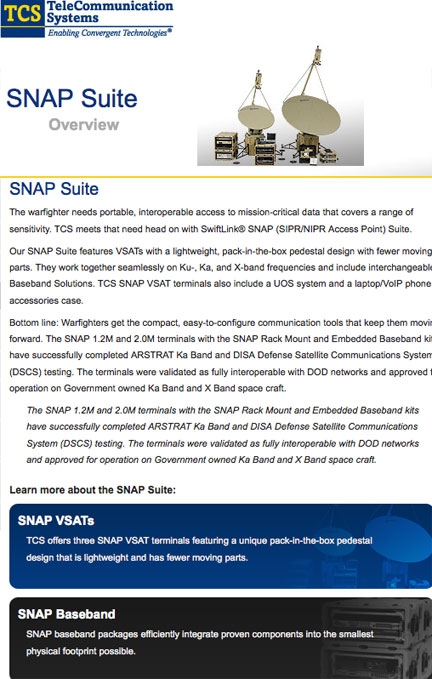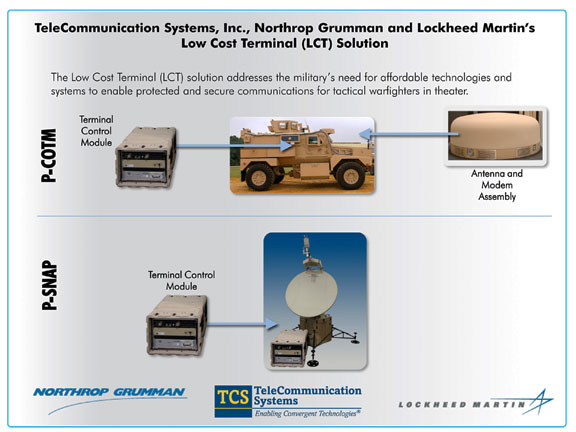 [SatNews] TeleCommunication Systems, Inc. (TCS) (NASDAQ: TSYS) has received a combined $5.5 million in delivery orders from...
[SatNews] TeleCommunication Systems, Inc. (TCS) (NASDAQ: TSYS) has received a combined $5.5 million in delivery orders from...
...the U.S. Army for equipment, field services support and maintenance of Secret Internet Protocol Router and Non-secure Internet Protocol Router Access Point (SNAP) Very Small Aperture Terminal (VSAT) satellite systems equipment. The U.S. Army Project Manager for the Warfighter Information Network - Tactical (PM WIN-T) Commercial Satellite Terminal Program is funding these procurements through the Army's $5 billion World-Wide Satellite Systems (WWSS) contract vehicle.
The TCS SNAP VSAT systems provide multimedia communications capabilities which convey encrypted voice, video and data. TCS SNAP products are highly transportable and ruggedized, and have a graphical user interface that facilitates easy set-up and operation. The modularity and plug-and-play interfaces between all radio frequency (RF) and baseband configurations inherent in the SNAP product line result in communication solutions tailored to the end-user's specific needs.
Additionally, TeleCommunication Systems, Inc., Northrop Grumman (NYSE: NOC) and Lockheed Martin (NYSE: LMT) have teamed to produce...
...highly affordable satellite terminals for protected communications on the move and at the halt. The Low Cost Terminal (LCT) solution addresses the military's need for lower cost technologies and systems to enable protected and secure communications for tactical warfighters in theater. The three companies are operating under a collaborative agreement signed earlier this year for TCS to manufacture, market and sell LCT products under license from Northrop Grumman and Lockheed Martin.
The LCT solution takes advantage of Northrop Grumman's and Lockheed Martin's proven knowledge and engineering experience in protected military satellite communications through Milstar and Advanced Extremely High Frequency (AEHF) anti-jam satellites, and builds on TCS' highly secure, deployable satellite communication systems, based on a modular architecture with plug-and-play interfaces and integrated logistics support. The LCT solution provides secure, assured, protected networks that offer anti-jam, low probability of interception (LPI)/low probability of detection (LPD) communications and cyber resistance.
As the next generation of AEHF satellites launch, the LCT solution will allow warfighters to quickly and affordably take full advantage of the satellites' improved capability and expanded capacity. The LCT offerings are designed to work cooperatively with existing systems and have the flexibility to accommodate future network architectures with only minimal software/firmware upgrades. With the more affordable LCT solution, protected satellite communications (P-SATCOM) becomes a viable option for tactical warfighters in the next couple of years. No other existing or developing terminals provide P-SATCOM for the tactical warfighter at similar price points or timetable; the LCT solution at full production levels is priced at one-tenth the price of fielded Extremely High Frequency (EHF) terminals.
The LCT solution enables assured, secure mission command at levels below the brigade combat team anywhere in the world. Developed entirely with company investment, the LCT solution includes two variants of equipment: a Protected Communications on the Move (P-COTM) terminal and a Protected SIPR/NIPR Access Point (P-SNAP) terminal for communications at the halt.
Developed jointly by Northrop Grumman and Lockheed Martin, the baseline terminal is interoperable with Milstar and AEHF satellite systems currently in orbit. Electronics transmit at 256Kbps and receive at 1.544Mbps, with an uplink performance of 256Kbps in rain or jamming environments. A tactically rugged terminal with a low-profile vehicle antenna was developed in three years, half the time of development cycles for fielded Milstar- and AEHF-compatible terminals. The hardware and software are extensible to other form factor terminals, such as small, fixed terminals that can be packed in transit cases, shipboard terminals for small deck ships, and low-cost airborne terminals for unmanned aerial vehicles and piloted aircraft.
Developed in collaboration with Northrop Grumman and Lockheed Martin, P-SNAP incorporates both SNAP and P-COTM components. The P-SNAP system is significantly smaller and lighter than currently available protected communication alternatives. The complete terminal system is packaged in three transit cases. Two people can easily set up the system within 30 minutes. P-SNAP is designed to support modular quick-change feeds and upgrade kits to provide backward compatibility for traditional SNAP operations in Ku- and Ka-bands.


